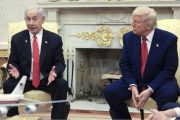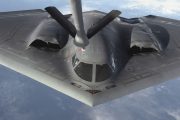
The United States under the Biden administration has unveiled a widespread campaign to prevent Iran from producing and supplying drones to Russia for use in the war in Ukraine. This campaign is reminiscent of longstanding U.S. policy to block Tehran’s access to nuclear technology.
Also, interviews of several intelligence, military, and national security officials in the United States, Europe, and the Middle East reveal an expanding U.S. campaign to make it more challenging for Russia to launch the unmanned “kamikaze” aircraft and — and as a last resort — to offer the Ukrainians with the defenses needed to shoot them out of the sky.
Recent weeks have unearthed the scope of such American efforts with the Biden administration stepping up its moves to choke Iran of the Western-made components necessary to produce the drones being sold to Russia after it became more evident from scrutinizing the wreckage of intercepted drones that contain made-in-America technology.
Moreover, U.S. forces have been involved in aiding Ukraine’s military to single out the locations where the drones are being prepared for launch — an uphill task as the Russians are shifting the launch sites around. Additionally, the United States is scrambling to gather new technologies such as missiles and gunfire to provide early indicators of approaching drone swarms so as to boost Ukraine’s chances of shooting them down.
However, the United States has been encountering hiccups in its efforts to deprive Iran of crucial components for the drones. Such challenges mirror the roadblocks experienced in the years-long attempt to block Iran from the parts needed to construct the delicate centrifuges it uses to enrich near-bomb-grade uranium.
Based on recent statements from U.S. intelligence officials, Iran is applying its expertise to the drone program on how to spread nuclear centrifuge manufacturing around the country and to find “dual use” technologies on the black market to go around export controls.
For years, one of the Iranian companies identified by Britain, France and Germany as a major producer of one of the two types of drones being purchased by the Russians, Qods Aviation, has emerged on the United Nations’ lists of suppliers to Iran’s nuclear and missile programmes. The company, which is owned by Iran’s military, has enlarged its range of drones notwithstanding various rounds of sanctions.
Notably the U.S. rush to tackle the Iranian-supplied drones comes at a key moment in the war, just as Ukraine is using its own drones to target deep into Russia, such as a recent attack on a base housing some of the country’s strategic bombers. Also, it comes amid warnings that Iran may be about to supply Russia with missiles, to address Moscow’s shortage.
Admittedly, both Iran and Russia are forging a new alliance of convenience due to their alienation by U.S.-led sanctions. One senior military official in the Western alliance said that partnership had intensified rapidly, after Iran’s agreement to supply drones to the Russians last summer “bailed Putin out”.
Britain has also accused Russia of planning to supply Iran advanced military components in exchange for hundreds of drones.
“Iran has become one of Russia’s top military backers,” Britain’s defense minister Ben Wallace told Parliament last week.
“In return for having supplied more than 300 kamikaze drones, Russia now intends to provide Iran with advanced military components, undermining both Middle East and international security – we must expose that deal,” he said.
What is more, Biden’s aides are also relying on Israel as an ally with a history of derailing Iran’s nuclear program.
In a recent secure video meeting with Israel’s top national security, military, and intelligence officials, national security adviser Jake Sullivan “discussed Iran’s growing military relationship with Russia, including the transfer of weapons the Kremlin is deploying against Ukraine, targeting its civilian infrastructure and Russia’s provision of military technology to Iran in return,” the White House said. It failed to elaborate on how the two countries decided to tackle the issue.
It is noteworthy that Israel and the United States have a track record of working together in countering technological threats posed by Tehran. Both countries developed one of the world’s most famous and sophisticated cyberattacks by using computer code that was later termed “Stuxnet” to undermine Iran’s nuclear centrifuge facilities. To boot, Israel has openly been trying to sabotage nuclear enrichment centers in Iran.
The head of Israel’s Mossad spy agency, David Barnea, said earlier in December that Iran is looking to expand its provision of advanced nuclear weapons to Russia, local media reported.
Barnea’s note of caution comes after the US previously voiced fears of a “full-scale defense partnership” between Tehran and Moscow.
“We warn against Iran’s future intentions, which they are trying to keep secret, to deepen and expand the supply of advanced weapons to Russia, to expand the uranium enrichment project and to intensify their attacks against friendly Muslim countries in the region,” Barnea was quoted as saying.
Although Tehran acknowledged in November that it had sent drones to Russia, it maintained that they were provided prior to the Ukraine war.
Adrienne Watson, the spokesman for the National Security Council, acknowledged the scope of the broad drive against Iran’s drone programme.
“We are looking at ways to target Iranian UAV production through sanctions, export controls, and talking to private companies whose parts have been used in the production,’’ she said, using the acronym for unmanned aerial vehicles.
Iran’s interest in drones originated more than 30 years ago, as the country searched for ways that it could survey ships in the Persian Gulf. The Mohajer I, a predecessor to one of the drones now being sold to the Russians, made its maiden flight in 1986.
In 2011, the Central Intelligence Agency took a stealthy, unarmed RQ-170 from the Pentagon’s fleet in Afghanistan and flew it over Iran, in what seemed to be an attempt to map some of the hundreds of tunnels dug by the Iranians to conceal evidence of their nuclear program.
When the aircraft eventually landed in the desert, and then-President Barack Obama mulled over deploying a Navy SEAL team to blow the aircraft up before Iranian engineers laid hands on it, according to senior officials. Obama did not proceed with his deployment, following which the Iranians paraded the drone through the streets of Tehran.
Subsequently, U.S. intelligence officials surmised that the aircraft enabled Iranian drone designers to reverse engineer the craft.
In 2016, Iran declared its plans to develop attack drones, some in collaboration with Russia. Many of the first drones were given to Iranian-backed militias, including Houthi rebels in Yemen, and they were used successfully in 2019 in attacks on two Saudi oil processing facilities operated by Saudi Aramco, the state-owned oil company.
The incidents in Saudi Arabia, and the targeting of American forces in Syria and elsewhere, gave the United States a taste of Iranian drone capabilities as well as the difficulty of tackling kamikaze raids in which a small explosive is secured in the drone’s nose.
Nonetheless, the fallout from the Ukraine war highlighted the fact that Iran could mass produce the aircraft, raising eyebrows in the West amid discussions of opening an Iranian plant inside Russia.
Notwithstanding years of sanctions on Iran’s defense sector, Iranian drones still are constructed mainly with American and Western parts. When photographs began to spread of circuit boards from downed drones, clearly assembled with chips from U.S. manufacturers, the White House demanded a clampdown, such as calls to the firms whose products had been discovered. Almost all had the same response: These are unrestricted, “dual use” items and stopping their circulation is almost impossible.
In September, the Biden administration increased sanctions, particularly identifying companies engaged in building the aircraft for Russia. In November, the U.S. government took action against companies such as Safiran Airport Services, a Tehran-based firm that it accused of transporting the drones for the Russian government.
As the Ukraine war drags on, the United States, Britain, France, and Germany are urging United Nations Secretary-General Antonio Guterres to conduct a formal investigation into whether Russia and Iran are breaching the terms of a UN restriction on the export of sophisticated arms from Iran.
In response, Guterres has clarified that his top priority is implementing a deal with Russia over the export of Ukrainian grain, to tackle shortages. His aides contend that now is not the time to jeopardize that agreement with an inquiry whose outcome is to be expected.
Moscow’s United Nations envoy, Vassily Nebenzia, declared at the Security Council that Russia’s military industrial complex “doesn’t need anyone’s assistance.”
He asserted that the drone accusations had been debunked several times.
Iran’s Foreign Ministry also remarked in a statement that it would not “seek permission from anyone” to deepen ties with Russia.“ Cooperation between Iran and Russia in various fields including defense is expanding within the framework of common interests … and is not against any third country,” said Foreign Ministry spokesman Nasser Kanani.




